Abstract
The mechanism of action of prostacyclin (PGI2) on isolated segments of guinea-pig terminal ileum was studied by recording the changes in isometric tension. In these preparations PGI2 (1 nM-1 microM) caused a concentration-dependent increase in muscle tension. This effect was rapid and short-lasting. PGI2-induced contractions were inhibited by atropine and potentiated by physostigmine. Hemicholinium-3 reduced the response to PGI2 and the inhibition was quantitatively comparable at any PGI2 concentration tested. Tetrodotoxin as well as low temperature (20 degrees C) abolished and beta-bungarotoxin reduced the effect of PGI2. Hexamethonium decreased the response to submaximal, but not to maximal PGI2 concentrations. PGI2 potentiated the twitch response of the ileum to electrical stimulation. In the presence of tetrodotoxin, PGI2 did not alter the effect of a sub-maximal concentration of acetylcholine (ACh). The present results give indirect evidence for the ability of PGI2 to facilitate ACh release from intramural nerves possibly by increasing the excitability of cholinergic cell bodies.
Full text
PDF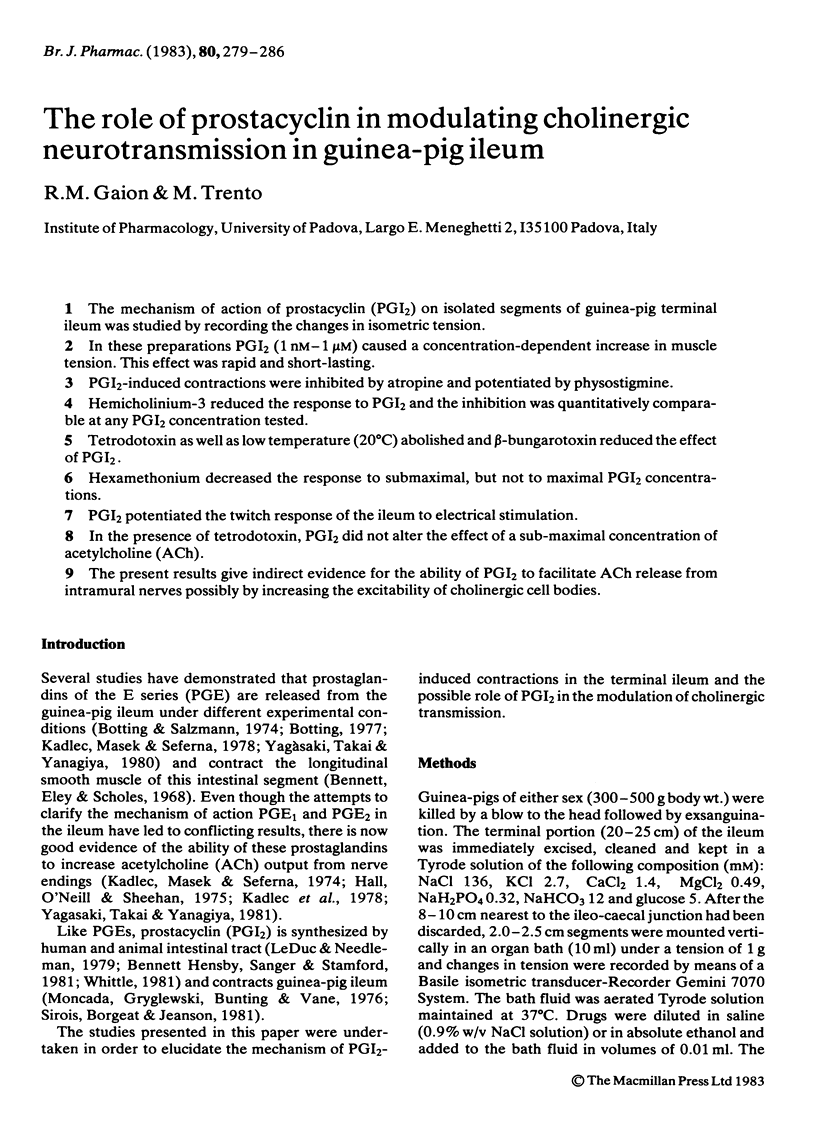
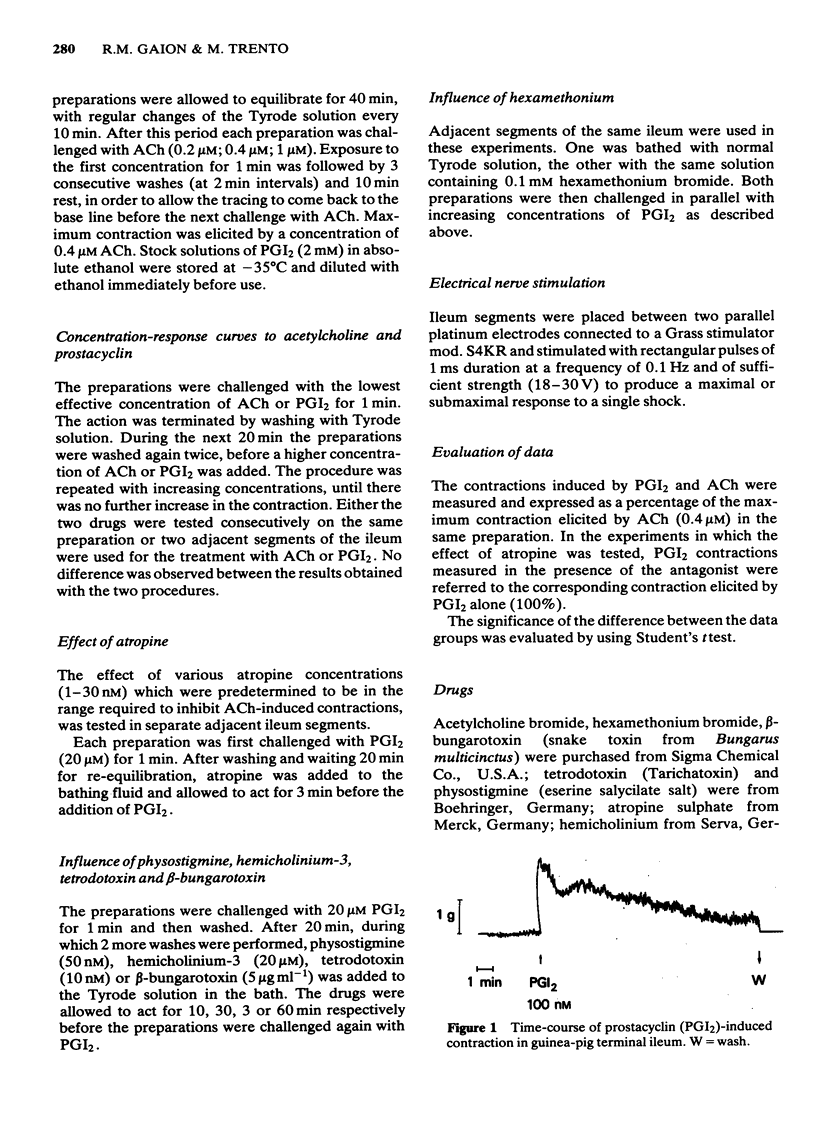

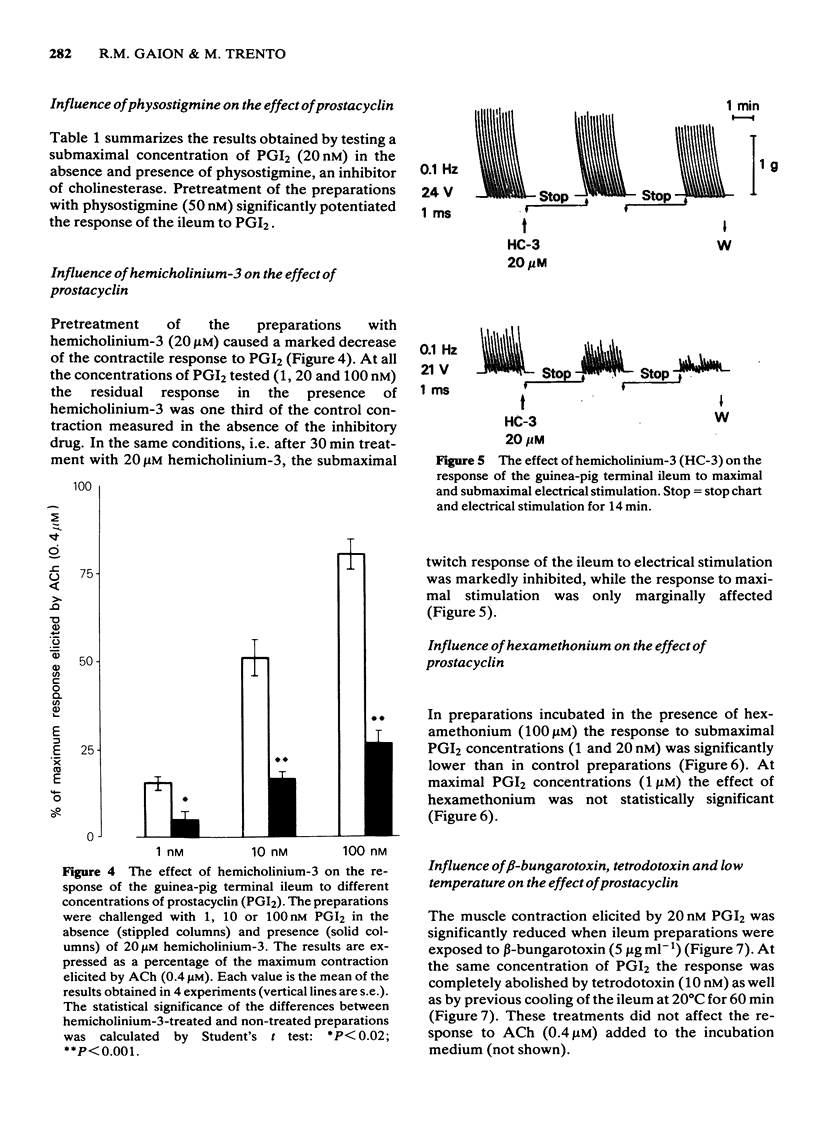
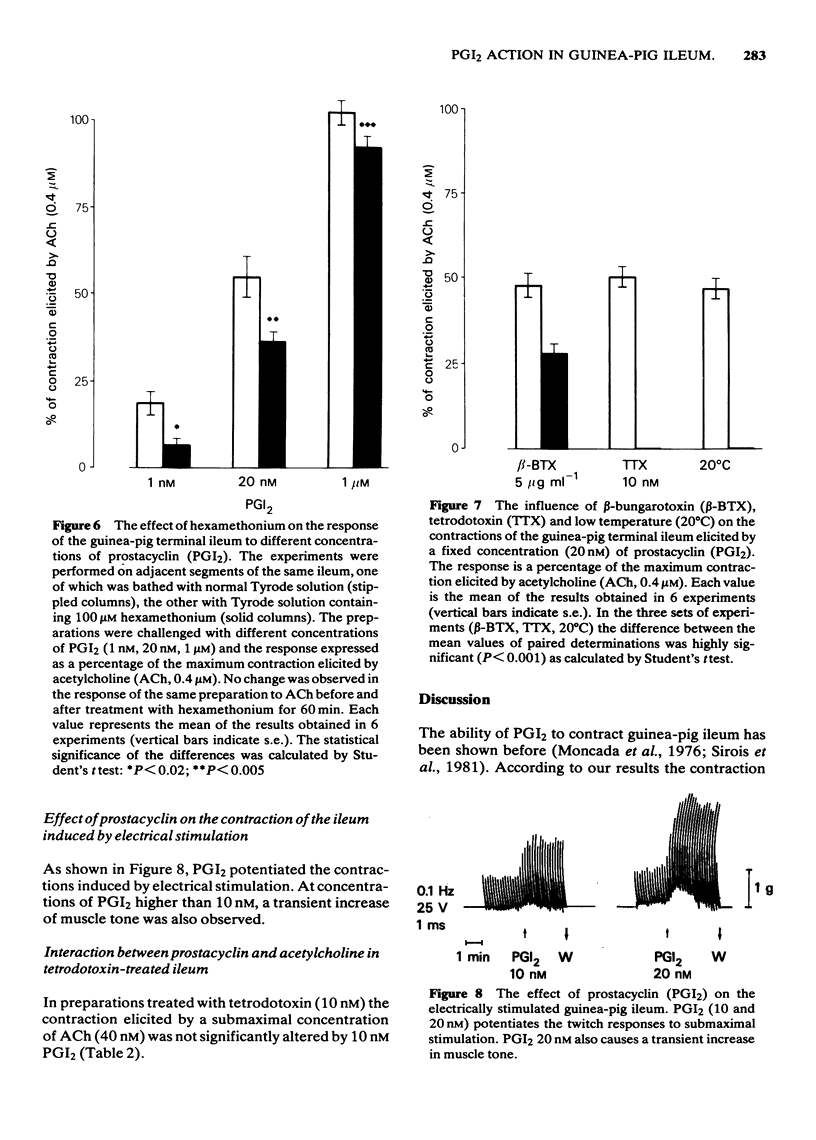
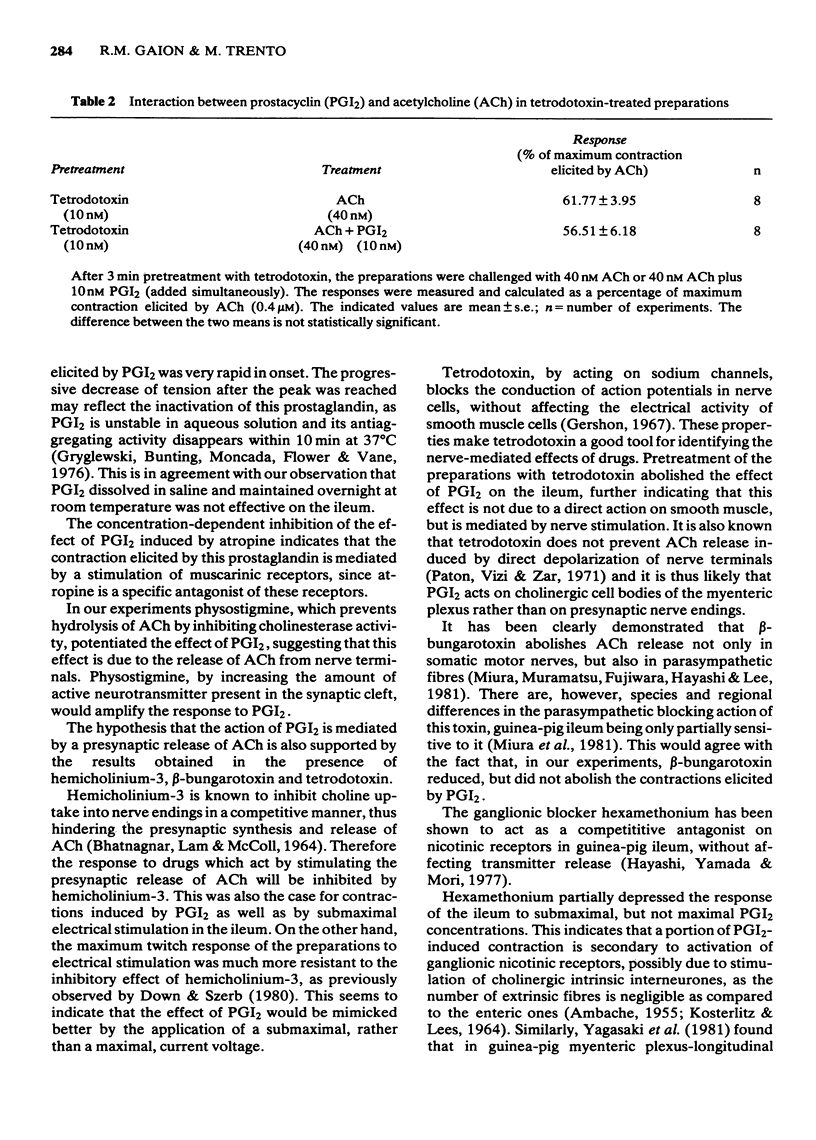
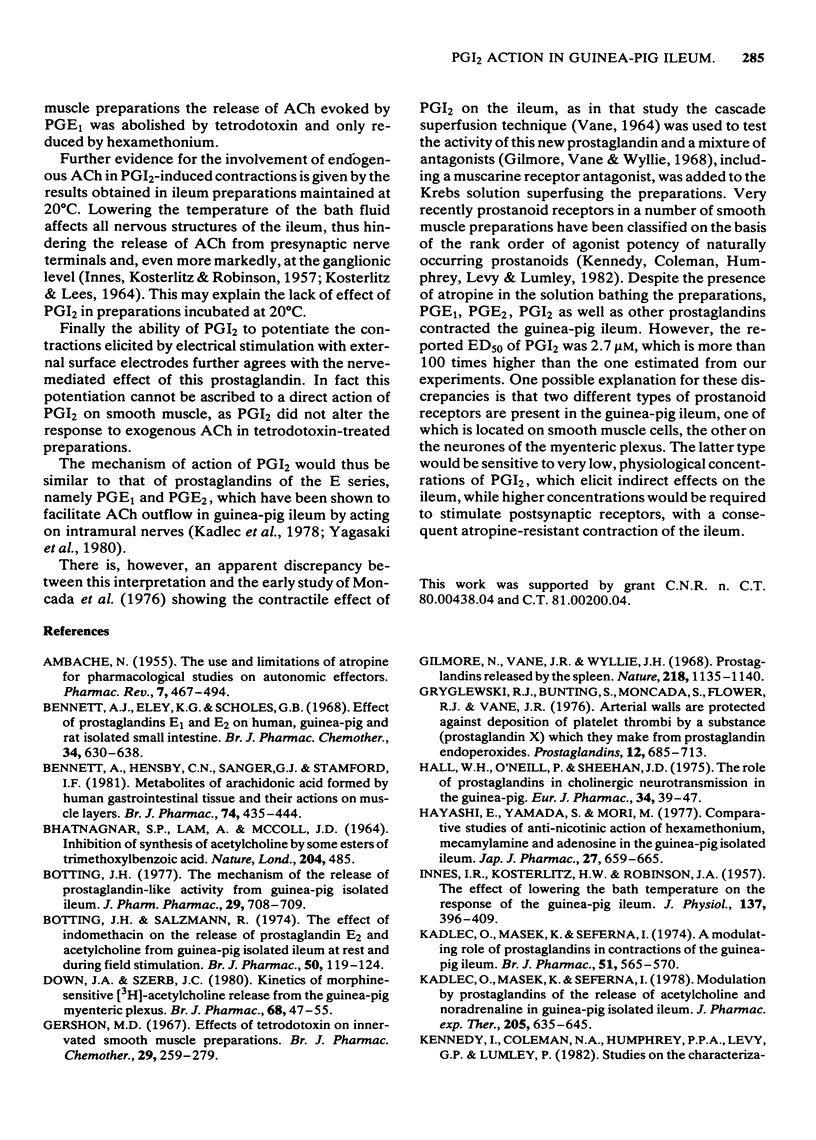
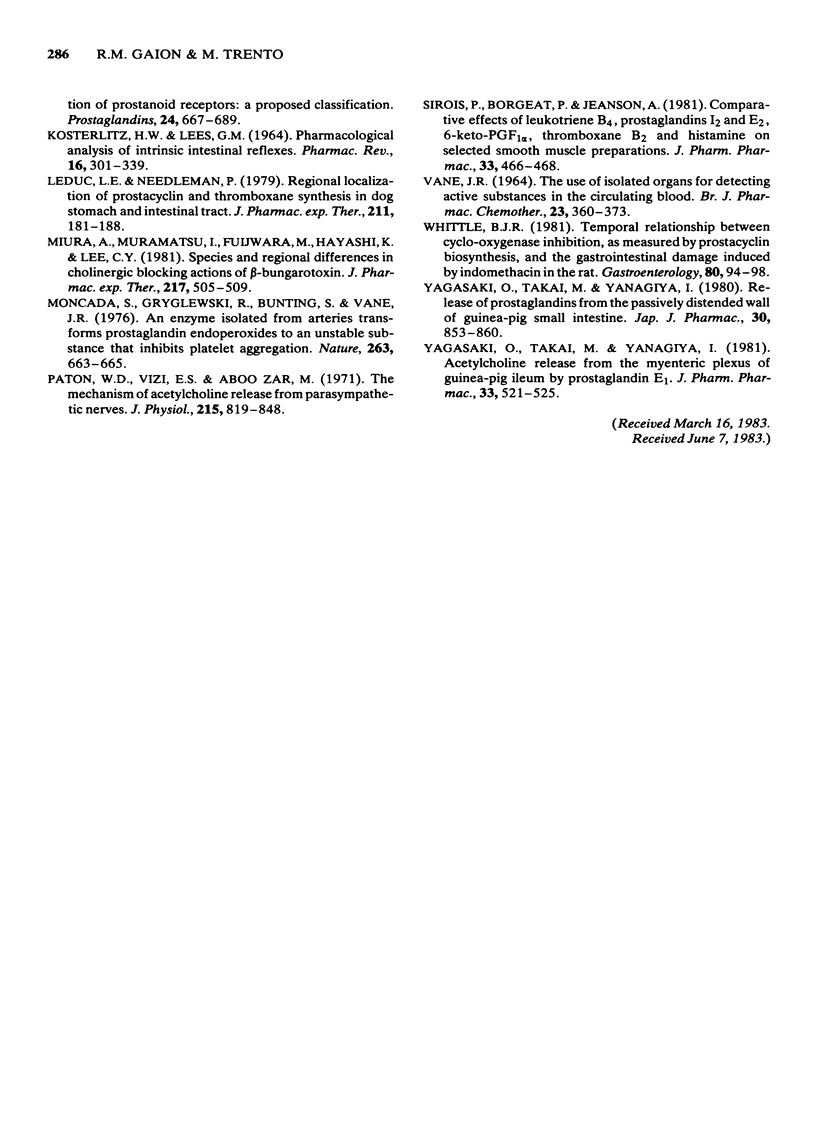
Selected References
These references are in PubMed. This may not be the complete list of references from this article.
- AMBACHE N. The use and limitations of atropine for pharmacological studies on autonomic effectors. Pharmacol Rev. 1955 Dec;7(4):467–494. [PubMed] [Google Scholar]
- BHATNAGAR S. P., LAM A., MCCOLL J. D. INHIBITION OF SYNTHESIS OF ACETYLCHOLINE BY SOME ESTERS OF TRIMETHOXYBENZOIC ACID. Nature. 1964 Oct 31;204:485–486. doi: 10.1038/204485b0. [DOI] [PubMed] [Google Scholar]
- Bennett A., Eley K. G., Scholes G. B. Effects of prostaglandins E1 and E2 on human, guinea-pig and rat isolated small intestine. Br J Pharmacol. 1968 Nov;34(3):630–638. doi: 10.1111/j.1476-5381.1968.tb08492.x. [DOI] [PMC free article] [PubMed] [Google Scholar]
- Bennett A., Hensby C. N., Sanger G. J., Stamford I. F. Metabolites of arachidonic acid formed by human gastrointestinal tissues and their actions on the muscle layers. Br J Pharmacol. 1981 Oct;74(2):435–444. doi: 10.1111/j.1476-5381.1981.tb09989.x. [DOI] [PMC free article] [PubMed] [Google Scholar]
- Botting J. H., Salzmann R. The effect of indomethacin on the release of prostaglandin E2 and acetylcholine from guinea-pig isolated ileum at rest and during field stimulation. Br J Pharmacol. 1974 Jan;50(1):119–124. doi: 10.1111/j.1476-5381.1974.tb09598.x. [DOI] [PMC free article] [PubMed] [Google Scholar]
- Botting J. H. The mechanism of the release of prostaglandin-like activity from guinea-pig isolated ileum. J Pharm Pharmacol. 1977 Nov;29(11):708–709. doi: 10.1111/j.2042-7158.1977.tb11444.x. [DOI] [PubMed] [Google Scholar]
- Down J. A., Szerb J. C. Kinetics of morphine-sensitive [3H]-acetylcholine release from the guinea-pig myenteric plexus. Br J Pharmacol. 1980 Jan;68(1):47–55. doi: 10.1111/j.1476-5381.1980.tb10697.x. [DOI] [PMC free article] [PubMed] [Google Scholar]
- Gershon M. D. Effects of tetrodotoxin on innervated smooth muscle preparations. Br J Pharmacol Chemother. 1967 Mar;29(3):259–279. doi: 10.1111/j.1476-5381.1967.tb01958.x. [DOI] [PMC free article] [PubMed] [Google Scholar]
- Gilmore N., Vane J. R., Wyllie J. H. Prostaglandins released by the spleen. Nature. 1968 Jun 22;218(5147):1135–1140. doi: 10.1038/2181135a0. [DOI] [PubMed] [Google Scholar]
- Gryglewski R. J., Bunting S., Moncada S., Flower R. J., Vane J. R. Arterial walls are protected against deposition of platelet thrombi by a substance (prostaglandin X) which they make from prostaglandin endoperoxides. Prostaglandins. 1976 Nov;12(5):685–713. doi: 10.1016/0090-6980(76)90047-2. [DOI] [PubMed] [Google Scholar]
- Hall W. J., O'Neill P., Sheehan J. D. The role of prostaglandins in cholinergic neurotransmission in the guinea pig. Eur J Pharmacol. 1975 Nov;34(1):39–47. doi: 10.1016/0014-2999(75)90223-x. [DOI] [PubMed] [Google Scholar]
- Hayashi E., Yamada S., Mori M. Comparative studies on anti-nicotinic action of hexamethonium, mecamylamine and adenosine in the guinea pig isolated ileum. Jpn J Pharmacol. 1977 Oct;27(5):659–665. doi: 10.1254/jjp.27.659. [DOI] [PubMed] [Google Scholar]
- INNES I. R., KOSTERLITZ H. W., ROBINSON J. A. The effects of lowering the bath temperature on the responses of the isolated guinea-pig ileum. J Physiol. 1957 Aug 6;137(3):396–409. doi: 10.1113/jphysiol.1957.sp005821. [DOI] [PMC free article] [PubMed] [Google Scholar]
- KOSTERLITZ H. W., LEES G. M. PHARMACOLOGICAL ANALYSIS OF INTRINSIC INTESTINAL REFLEXES. Pharmacol Rev. 1964 Sep;16:301–339. [PubMed] [Google Scholar]
- Kadlec O., Masek K., Seferna I. A modulating role of prostaglandins in contractions of the guinea-pig ileum. Br J Pharmacol. 1974 Aug;51(4):565–570. doi: 10.1111/j.1476-5381.1974.tb09675.x. [DOI] [PMC free article] [PubMed] [Google Scholar]
- Kadlec O., Masek K., Seferna I. Modulation by prostaglandins of the release of acetylcholine and noradrenaline in guinea-pig isolated ileum. J Pharmacol Exp Ther. 1978 Jun;205(3):635–645. [PubMed] [Google Scholar]
- Kennedy I., Coleman R. A., Humphrey P. P., Levy G. P., Lumley P. Studies on the characterisation of prostanoid receptors: a proposed classification. Prostaglandins. 1982 Nov;24(5):667–689. doi: 10.1016/0090-6980(82)90036-3. [DOI] [PubMed] [Google Scholar]
- LeDuc L. E., Needleman P. Regional localization of prostacyclin and thromboxane synthesis in dog stomach and intestinal tract. J Pharmacol Exp Ther. 1979 Oct;211(1):181–188. [PubMed] [Google Scholar]
- Miura A., Muramatsu I., Fujiwara M., Hayashi K., Lee C. Y. Species and regional differences in cholinergic blocking actions of beta-bungarotoxin. J Pharmacol Exp Ther. 1981 May;217(2):505–509. [PubMed] [Google Scholar]
- Moncada S., Gryglewski R., Bunting S., Vane J. R. An enzyme isolated from arteries transforms prostaglandin endoperoxides to an unstable substance that inhibits platelet aggregation. Nature. 1976 Oct 21;263(5579):663–665. doi: 10.1038/263663a0. [DOI] [PubMed] [Google Scholar]
- Paton W. D., Vizi E. S., Zar M. A. The mechanism of acetylcholine release from parasympathetic nerves. J Physiol. 1971 Jul;215(3):819–848. doi: 10.1113/jphysiol.1971.sp009500. [DOI] [PMC free article] [PubMed] [Google Scholar]
- Sirois P., Borgeat P., Jeanson A. Comparative effects of leukotriene B4, prostaglandins I2 and E2, 6-keto-PGF1 alpha thromboxane B2 and histamine on selected smooth muscle preparations. J Pharm Pharmacol. 1981 Jul;33(7):466–468. doi: 10.1111/j.2042-7158.1981.tb13836.x. [DOI] [PubMed] [Google Scholar]
- VANE J. R. THE USE OF ISOLATED ORGANS FOR DETECTING ACTIVE SUBSTANCES IN THE CIRCULATING BLOOD. Br J Pharmacol Chemother. 1964 Oct;23:360–373. doi: 10.1111/j.1476-5381.1964.tb01592.x. [DOI] [PMC free article] [PubMed] [Google Scholar]
- Whittle B. J. Temporal relationship between cyclooxygenase inhibition, as measured by prostacyclin biosynthesis, and the gastrointestinal damage induced by indomethacin in the rat. Gastroenterology. 1981 Jan;80(1):94–98. [PubMed] [Google Scholar]
- Yagasaki O., Takai M., Yanagiya I. Acetylcholine release from the myenteric plexus of guinea-pig ileum by prostaglandin E1. J Pharm Pharmacol. 1981 Aug;33(8):521–525. doi: 10.1111/j.2042-7158.1981.tb13851.x. [DOI] [PubMed] [Google Scholar]


